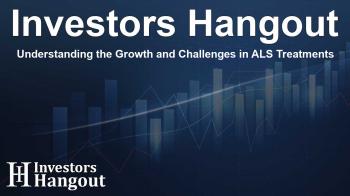Understanding the Growth and Challenges in ALS Treatments

The Expanding Landscape of ALS Treatment
The global amyotrophic lateral sclerosis (ALS) treatment market is on a promising trajectory, anticipated to grow significantly over the coming years. The market is projected to see a rise from USD 724.5 million to USD 1,234.5 million, with a compound annual growth rate (CAGR) of 6.1%. This upward trend can largely be attributed to an aging population worldwide, advancements in new therapies, and an increasing number of ALS cases.
Understanding ALS and Its Impact
Amyotrophic lateral sclerosis is a progressive neurodegenerative disease that primarily affects adults, particularly those between the ages of 60 and 79. The urgency in addressing this condition is underscored by statistical insights from national registries, which suggest that cases in the U.S. alone are likely to rise significantly in the near future. With the burden of the disease often leading to serious healthcare challenges, rapid interventions and proactive management strategies have become essential.
Current ALS Treatment Challenges
Despite advancements, the ALS treatment landscape is not without significant hurdles. The escalating cost of care, particularly in the late stages of the disease, creates a financial strain for many families, with expenses often exceeding $120,000 annually. Factors like delays in diagnosis and the complexities of specialized care compound these issues, making effective treatment accessibility a critical concern. Innovative therapies that show promise often come with hefty price tags, emphasizing the need for more affordable options.
Recent Innovations in ALS Care
Exciting new developments are emerging in the realm of ALS treatment. For instance, the FDA's accelerated approval of therapies like Tofersen marks a significant milestone in utilizing biomarkers to gauge treatment efficacy. The focus on neurofilament light chain (NfL) as a key biomarker is transforming how researchers develop and assess new treatments. This progress indicates a shift towards more personalized care strategies for ALS patients.
The Role of Biomarkers
The integration of biomarkers is reshaping the diagnostic and therapeutic approaches in ALS. Research institutions, including the National Institutes of Health, are promoting efforts to validate biomarkers that can facilitate quicker diagnoses and improved treatment outcomes for ALS patients. These research initiatives aim to enhance prognostic accuracy and customize treatment paths based on individual patient profiles.
ALS Treatment Innovations Across Regions
Across the globe, regions are adapting to the challenges presented by ALS. North America is currently leading in ALS research and development, largely due to strong regulatory frameworks and the involvement of key organizations advocating for ALS research. Canada is also playing an integral role in improving care standards through national health registries.
In Europe, initiatives are underway to enhance participation in clinical trials, with collaborative efforts among numerous centers aimed at providing patients with greater access to experimental therapies. Meanwhile, in the Asia-Pacific, countries are establishing specialized ALS centers and investing in professional education to improve patient care standards.
The Future of ALS Treatments
The future holds promise, with stem cell therapies showing encouraging preliminary outcomes. Recent studies highlight the role of mesenchymal stem cells in delaying disease progression, indicating a path forward that could significantly alter ALS management. This revolutionary approach, combined with advancements in genetic therapies, suggests that the treatment landscape for ALS may undergo substantial transformation in the coming years.
Key Players in ALS Treatment Development
Prominent companies such as MediciNova, Mitsubishi Tanabe Pharma, and Ionis Pharmaceuticals are at the forefront of ALS research and therapeutic development. Their commitment to advancing treatment options is reshaping the future for patients living with ALS, with many companies actively pursuing innovations that could lead to more effective and targeted therapies.
Frequently Asked Questions
1. What is ALS and what are its common symptoms?
Amyotrophic lateral sclerosis (ALS) is a progressive neurodegenerative disease affecting nerve cells in the brain and spinal cord, leading to muscle weakness, speech difficulties, and eventually paralysis.
2. How is the ALS treatment market evolving?
The ALS treatment market is expanding, driven by advances in drug discovery, increased research funding, and a growing focus on personalized treatment approaches.
3. What role do biomarkers play in ALS treatment?
Biomarkers help in early detection and monitoring of ALS, performing as critical indicators of disease progression and therapeutic efficacy, which streamlines treatment options.
4. What challenges does the ALS community face?
Challenges include high treatment costs, delayed diagnoses, and the need for effective, affordable therapies that can improve patient outcomes.
5. What is the outlook for ALS treatments in the next decade?
With ongoing research and innovation, the outlook is optimistic, promising a shift toward more effective, personalized, and accessible treatment options for ALS patients.
About The Author
Contact Olivia Taylor privately here. Or send an email with ATTN: Olivia Taylor as the subject to contact@investorshangout.com.
About Investors Hangout
Investors Hangout is a leading online stock forum for financial discussion and learning, offering a wide range of free tools and resources. It draws in traders of all levels, who exchange market knowledge, investigate trading tactics, and keep an eye on industry developments in real time. Featuring financial articles, stock message boards, quotes, charts, company profiles, and live news updates. Through cooperative learning and a wealth of informational resources, it helps users from novices creating their first portfolios to experts honing their techniques. Join Investors Hangout today: https://investorshangout.com/
The content of this article is based on factual, publicly available information and does not represent legal, financial, or investment advice. Investors Hangout does not offer financial advice, and the author is not a licensed financial advisor. Consult a qualified advisor before making any financial or investment decisions based on this article. This article should not be considered advice to purchase, sell, or hold any securities or other investments. If any of the material provided here is inaccurate, please contact us for corrections.

